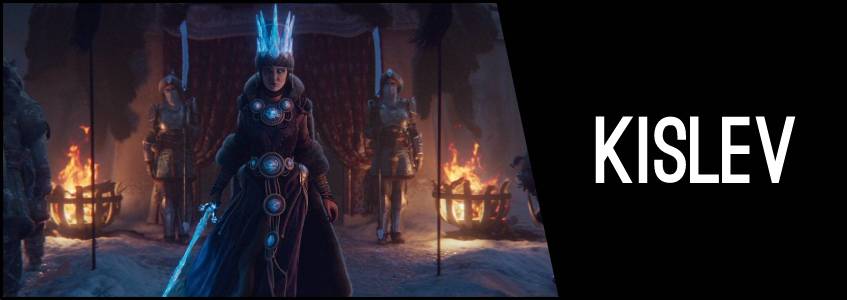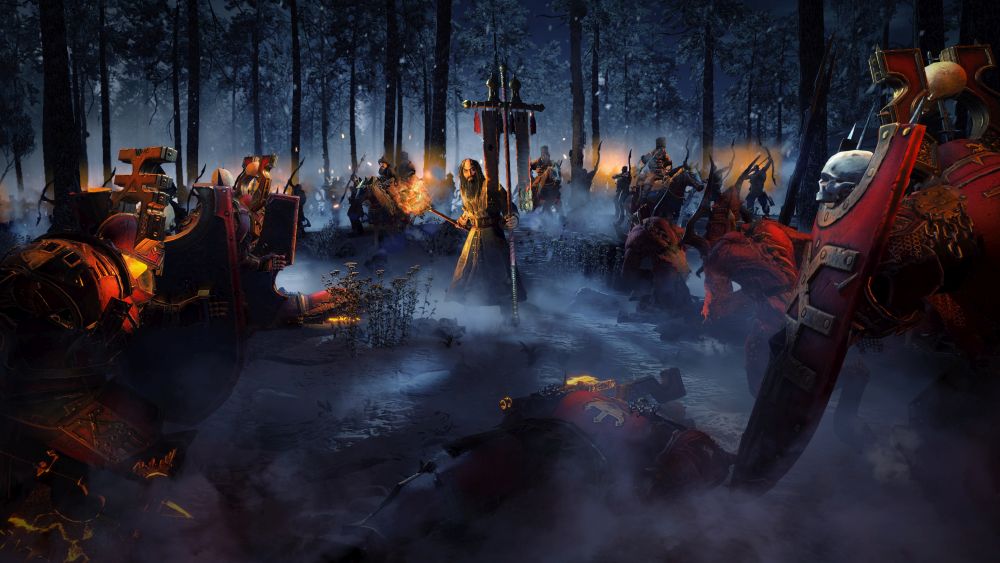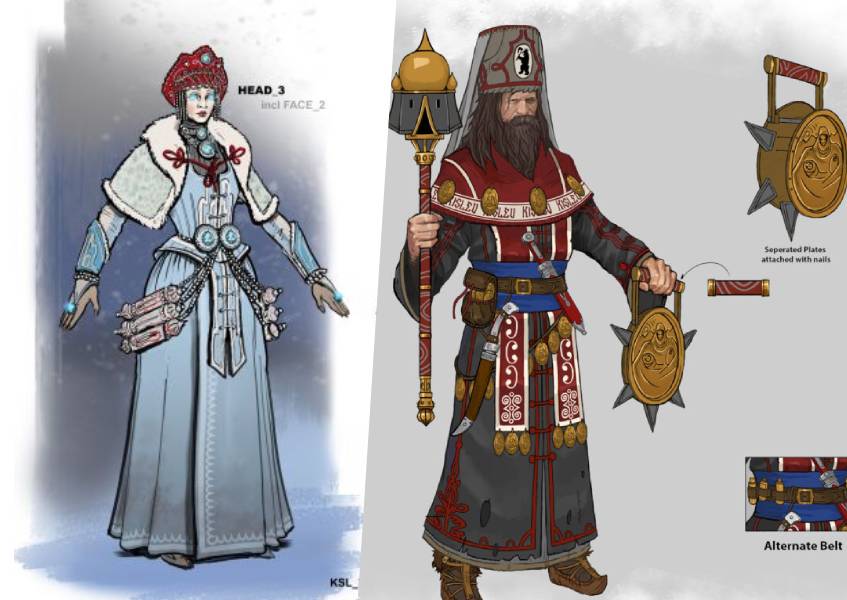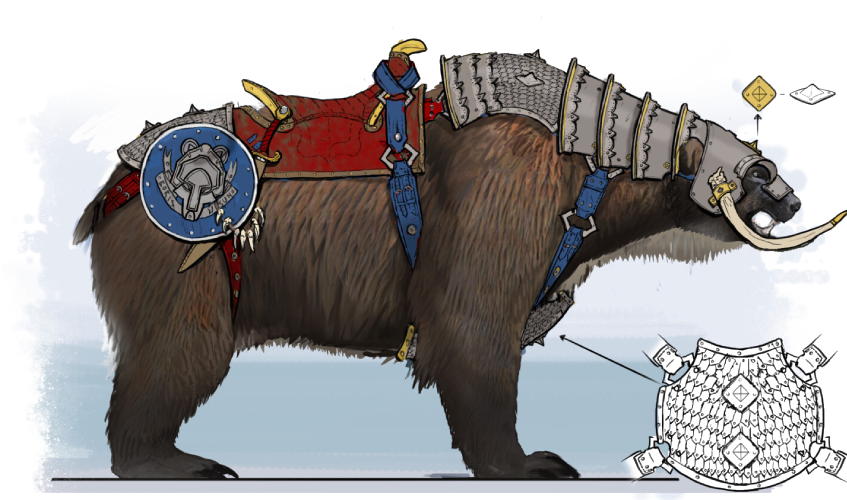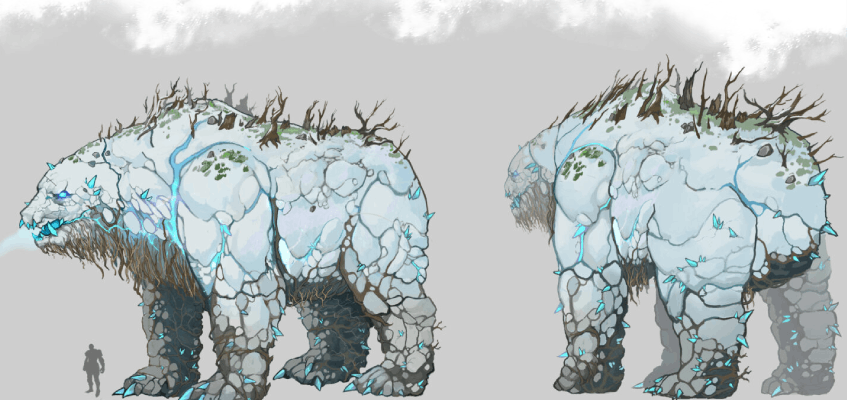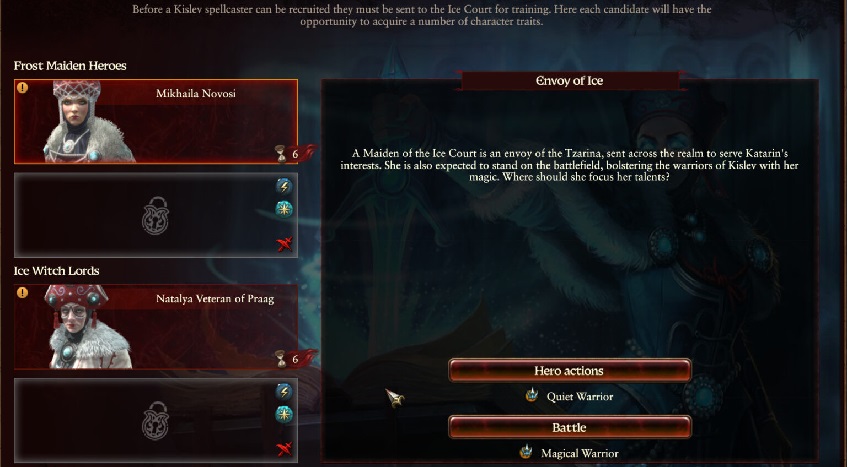Kislev is one of the playable races of the Total War: Warhammer 3 game at release. Kislev standing as the bulwark against Chaos to protect the Realms of Man, the men, woman, and bears of Kislev are resulte in not allowing trheir homeland to become corrupted.
From the lowliest farmer to the mightiest bear rider, the snow leopards that prowl the wastes to the living embodiment of the land itself and the people’s god – all are prepared to fight for every inch of territory and never allow Chaos to gain a foothold. Should they fall, all will surely follow.
- Corruption – Untained
- Climates
- Suitable: Unknown
- Unpleasant: Unknown
- Uninhabitable: Unknown
Tzarina Katarin
- Name: Tzarina Katarin
- Faction: The Ice Court
- Race: Kislev
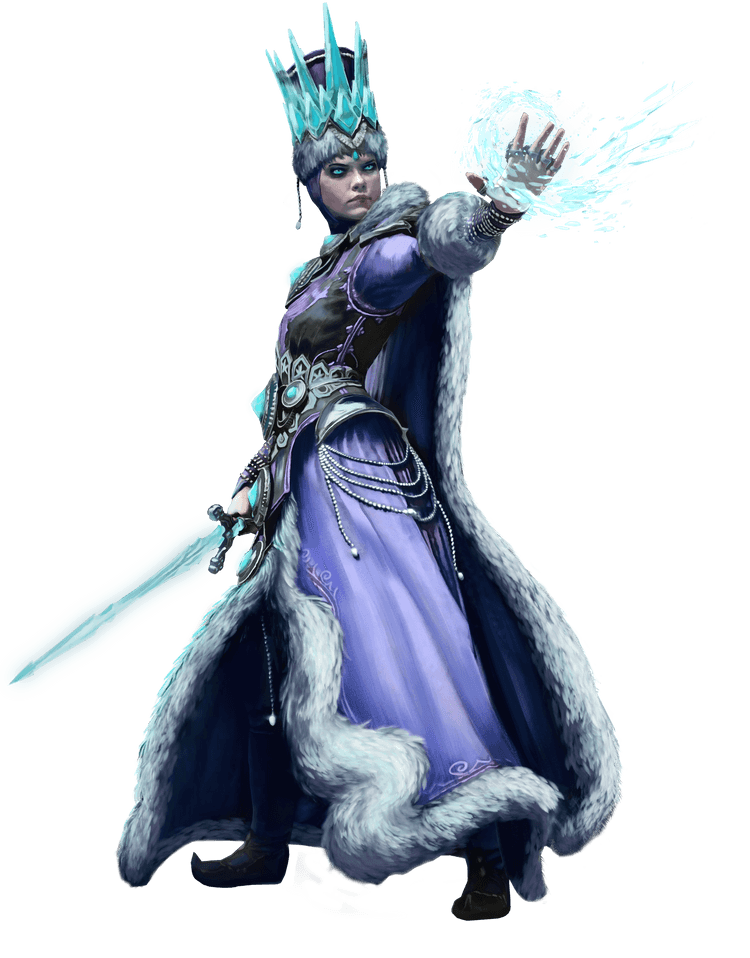
Kostaltyn
- Name: Kostaltyn
- Faction: The Great Orthodoxy
- Race: Kislev
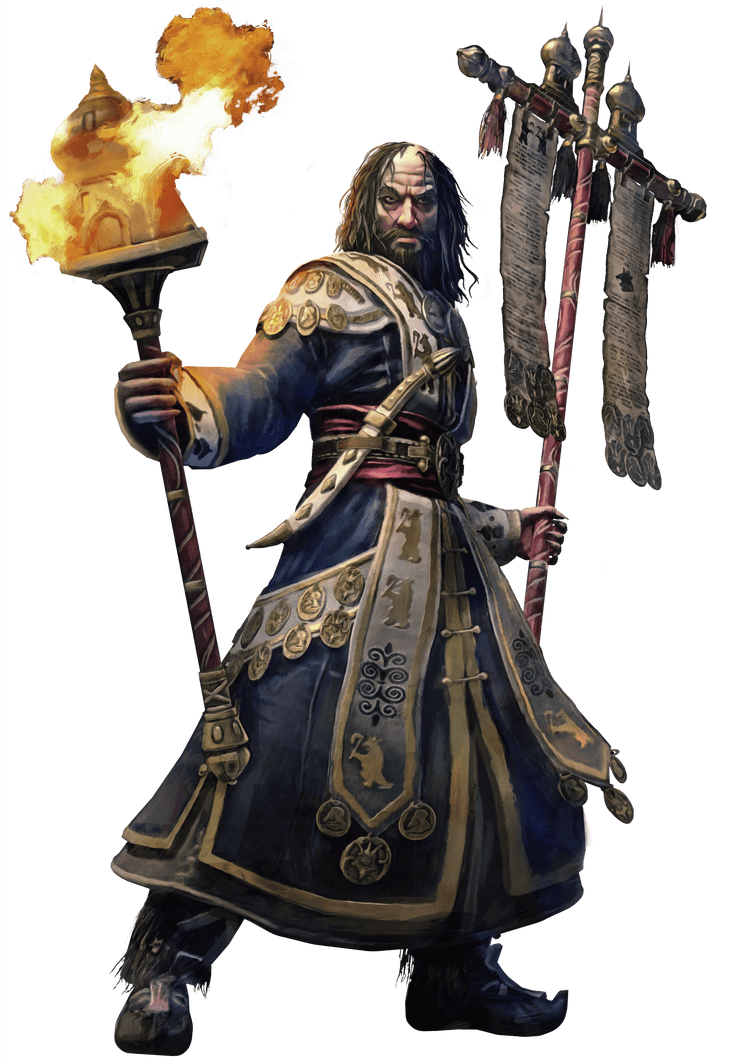
Table of Contents
Kislev Legendary Lords
Kislev has two Legendary Lords at the launch of the Total War: Warhammer 3 game. Tzarina Karain the Ice Witch and Kostaltyn the Supreme Patriarch.
Tzarina Katarin – Legendary Lord Kislev
Ascending to the throne and crown in the wake of her father’s bloody death fighting against the hordes of Chaos, Katarin has wasted no time cementing her grip upon Kislev. She is, in every way, a totalitarian ruler. She is stern and unflinching and will readily have rivals removed by agents of the crown if she cannot win them over with cold reason. The base of Katarin’s power, beyond hereditary right, is her extraordinary magical prowess. She is the greatest Ice Witch for generations, capable of magical feats more deadly and devastating than any other Ice Witch in Kislev.
The leader of the Ice Court, Katarin is more adept at training and maintaining the Frost Maidens who call it home and the Ice Guard who protect them. As the most powerful Ice Witch of her age she is unlikely to miscast, and as the ruler of Kislev she crushes rebellion and corruption wherever she goes.
Mounts: Warhorse or War Bear
Selection of unique spells, abilities, or skills of Tzarina Katarin:
- Loremaster, Lore of Ice – Katarin is a complete master of the lore of ice, making her spells deadlier, cheaper, and faster.
- Frost Fang – Katarin’s legendary blade, Frost Fang, bestows upon her a huge number of incredible powers, chief among them its titular, explosive spell.
Kostaltyn Supreme Patriarch – Legendary Lord Kislev
Ursun is not a vicious god (although he is both brutal and merciless in times of war). To his followers, he is fatherly and large. Kostaltyn is the Supreme Patriarch of the Ursunite Cult and as the highest ranking clergy in the nation, the de facto leader of the Grand Orthodoxy. With wild hair, wilder eyes, and wither-thin limbs, Kostaltyn is a ghoulish figure, robed in the finery of the resurgent Ursunite faith.
He is a howling, angry firebrand, screaming furious rhetoric at the enemy and urging the warriors around him to fight on with a fearful mixture of encouragement and threat. For he is himself fearless, able to recover from any wound quickly and thus inspire his flock to run pell-mell at foes that any sane person would flee!
With complete control of the faith that binds Kislev together, Kostaltyn whips his followers into a holy fervour. He despises the machinations of the Tzarina and her Ice Court and considers them usurpers and magic-wielding heretics.
Mounts: Warhorse or War Bear
Selection of unique spells, abilities, or skills of Kostaltyn:
- Ursun’s Ward – Kostaltyn is an unkillable paragon of his people, and even the most mortal wounds simply power him to greater heights of ferocity as he faces down his enemies.
- Man of the People – Kostaltyn’s fervor means he never lacks faithful, loyal warriors to send into battle.
Kislev Lords
From the unit roster reveal we know that Kislev will have Lords called Boyard and Ice Witch. The Boyard Lords are upfront fighters, whereas the Ice Witch Lords are casters that have access to the lore of ice and lore of tempest. Both of them can use a Warhorse or War Bear mount.
Boyard – Kislev Lord
Ranking nobles, Boyars are powerful men and women within Kislev. They each govern specific areas of Kislev, including scores if not hundreds of stanitsas, as well as larger towns and small cities. Especially large cities are governed by Boyars of singular prestige. This is a hereditary rank, although royal edict can raise one to the position. On the battlefield, they are tough and doughty fighters – the best in Kislev.
Boyars serve the people in battle as extraordinary warriors, leading their forces from the front and clashing with enemies of every kind. They are inspiring commanders and deadly foes.
Mounts: Warhorse or War Bear
Ice Witch – Kislev Lord
Kislev has no colleges of magic. Instead, its sorcery is derived from within the Ice Court, and invariably reflects the brutal winters of Kislev. It is from this body that the Ice Witches are drawn. Their Ice Magic is the raw, murderous power of cold, harnessed as a weapon – from frozen ground that binds the foe’s feet to lances of icy death. While all magic is drawn from the raging Winds, there is no doubt that Ice Magic is strongest when used within the borders of Kislev itself.
Lore of Ice, which specialises in disrupting enemy movement, freezing them to death, as well as encasing allies in protective barriers or equipping them with armour-piercing weapons.
- Ice Sheet
- Ice Maiden’s Kiss
- Frost Blades
- Death Frost
- Crystal Sanctuary
- Heart of Winter
Lore of Tempest, which speeds allies and sends enemies to a swift death, harried from all sides by incredible blizzards and the biting cold.
- Gust of True Flight
- Hailstorm
- Swiftwing
- Biting Wind
- Hawks of Miska
- Blizzard
Mounts: Warhorse or War Bear
Kislev Heroes
With the launch of Total War: Warhammer 3 you will have access to two hero types for Kislev. The Frost Maiden and the Patriarch. Like the Lords they will also be able to use the Warhorse or War Bear mounts.
Frost Maiden Hero
When the Tzarina’s personal attention is not required, it falls to the women of the Ice Court to represent her might instead. Since the time of the Khan Queens there has been an Ice Court, a powerful political body devoted to preparing the noble daughters of Kislev to take on positions of power. It is from this body that the Frost Maidens – Ice Witches yet to complete their training – are drawn. Akin to an academy, the Ice Court schools the young women within its halls in matters of diplomacy, intrigue and sorcery.
Lores: Ice or Tempest
Mounts: Warhorse or War Bear
Patriarch Hero
The sentinels of the Kislevite faith. Bombastic, loud, and proud of their creed, they exhort the warriors around them to acts of courage, protecting them with the power of faith. Patriarchs stride into battle bellowing the folk-songs of the Kislevite people with the cadence of battle-hymns – and mighty miracles of war are wrought by their belief. Bones of long-dead Kislevite heroes are carried in reliquary boxes, and those nearby take heart… although whether they hold any true magical properties remains a topic of speculation.
Ability selection:
- Ursun’s Roar
- Dazh’s Song of Winter Sunlight
- Tor’s Battle Hymn
- Salyak’s Lullaby
Mounts: Warhorse or War Bear
Kislev Units in Warhammer 3
Now lets take a closer look at all the revealed units for Kislev in Total War: Warhammer 3.
Kislev Missle Infantery
First lets take a look at all the missle infantery that Kislev will have.
Kossars
Kossars are the mainstay of the Kislevite armies, regiments of grizzled and hardened fighters, drawn primarily from among the many thousands of foresters and trappers who keep Kislev’s stanitsas and cities fed. They fight with bows and axes, the two traditional weapons of the Kossars – symbolising the woodsman and the hunter. This ornate wargear is wrought to last a lifetime if well-cared for. Many is the wizened old Kislevite who has handed their axe down to their grandchild, telling tall tales of the countless Marauders or Chaos beasts it has slain.
While Kossars fight in regiments, they are not necessarily the most disciplined warriors, at least on the face of it. These hard-living layfolk of Kislev are fatalistic about the bitterness of warfare, drinking together by the fire at night and singing raucous anthems as they march, joking constantly at one another’s expense. They wear light armour, if any at all.
Variants:
- Bow & Axe
- Bow & Spear
Notable characteristics of the Kossars unit from Kislev:
- The backbone of the Kislevite army, cheap and easy to build.
- As with all Kislev units, can keep their leadership in even the direst of circumstances.
- Early access to both bows and spears allows for a hybrid, powerful army from the off.
Streltsi
The Streltsi were originally armed with bardiches and handguns, in order that they could rest their firearm upon the crook of their polearm and thereby achieve greater accuracy. However, in an effort to get ‘one more’ shot off before the enemy closed upon them, the warriors would often run out of time to effectively stow their gun and ready their bardiche. Instead, the heavy gun was often simply reversed and used as a bludgeon. Eventually, Streltsi captains took the radical step of embracing this alternative approach and had their rotas’ rifles modified to include axeblades on the gun stock.
Notable characteristics of the Streltsi unit from Kislev:
- Their signature gun-greataxe represents both the coolest hybrid weapon in Warhammer history and one of the best.
- Also based on a real 16th century weapon.
- Armoured and armour-piercing, with decent melee abilities to go alongside their shooting prowess.
Ice Guard
In Kislev, the voice of a woman is equal to that of a man, and the worth of a ruler is judged by the wisdom of their rule and their might in battle. Perhaps that, more than any other reason, gave rise to the unusual sisterhood known as the Ice Guard. These are the warrior elite of the Ice court, a bodyguard for the Ice Witches, and who are imbued with the same magical power as their mistresses. They are fearsome and fearless, conditioned to put Kislev first and to face the vilest horrors of the Old World without hesitation.
The Ice Guard is staffed by formidable warrior women, sent to the Bohka Palace before they reach adolescence. These youths are then sorted for their aptitude for magic. Those with the gift begin a training regimen that will enable them to take their place within the Ice Court, a clandestine place of intrigue and power, typically headed by the senior matriarch of the Kislevite royal family. Each weapon these women wield is imbued with ice magic, glowing with its own inner light.
Variants:
- Bow & Dual Sword
- Bow & Glaive
Notable characteristics of the Ice Guard unit from Kislev:
- Fearless and stout, the women of the Ice Guard will face any foe.
- Frostbite consumes targeted enemies, slowing them.
- Anti-infantry and anti-large variants make them another useful, hybrid unit for Kislev armies.
Kislev Infantery
Next up we have the infantery units that Kislev will offer.
Armoured Kossars
Armoured Kossars are full-time soldiers, either paid by the crown or simply supported by their wealthy families. As such, their time is spent entirely either training or carousing. They are dour, grim-faced killers on the battlefield, but after the battle is done, they are the most belligerent, boisterous, and hard-drinking of all the celebrants at a victory feast. Arrogance, reinforced by undeniable results – these are warriors as good as an ordinary man can hope to become. They wear heavy armour above the waist, and sturdy reinforced boots, though their legs are clad only in baggy trousers.
Variants:
- Pistol & Axe + Shield
- Pistol & Greatmace
Notable characteristics of the Armoured Kossars unit from Kislev:
- Pistols, while limited in ammunition, give Armoured Kossars a great first punch.
- Greatmaces crush skulls and smash armour to pieces.
- Love a post-battle drink.
Tzar Guard
Regiments of hardened warriors, formed of lesser nobles and veteran soldiers elevated to higher status from the ranks of the Kossars, the Tzar Guard are formidable, durable melee troops. Originally, they were instituted to serve as the Tzar’s personal retinue, and while he would invariably travel with a large warband of Tzar Guard at his back, almost every army of Kislev now boasts a regiment or two of these hardened warriors. This is because every Boyar and Marshal needs a steady core to their army – veteran warriors able to act as the bulwark of the Kislevite battle line.
Variants:
- Sword & Shield
- Greatsword
Notable characteristics of the Tzar Guard unit from Kislev:
- The most elite fighting force and personal guard of Tzarina Katarin.
- Hardy, difficult to kill, armoured, and with the option of carrying greatswords into battle.
- While slower than their less-trained peers, make up for it with incredible battle capabilities.
Kislev Cavalry
Now onto the cavalry units of Kislev, there are plenty available in Warhammer 3.
Kossovite Dervishes
Much of Kislev is known as the Oblast, a huge, open wilderness. It is said that one’s horse is one’s life when on the Oblast – this is not a joke or an old wives’ tale, but rather the cold, hard truth. If a Kislevite rider is freezing, they warm their steed first. If they are thirsty, it drinks before them. Why? Because without a horse, if the hunters of the Dark Gods don’t catch them, the Motherland’s wintery embrace will make an orphan of their children just as readily.
Notable characteristics of the Kossovite Dervishes unit from Kislev:
- Can sneak up to enemy lines for Vanguard Deployment.
- Incredible speed from well-bred, cared-for horses.
- The quintessential hit-and-run attacker – don’t leave them in a straight fight for long.
Winged Lancers
Every settlement large enough will support a rota of Kislevite Winged Lancers, a cavalry squadron of hardy, well-trained warriors who form the offensive heart of almost every Kislev army. They are also a potent psychological weapon, for at full gallop they cause the very air to shudder and roar. Becoming a Kislev Winged Lancer takes dedication and effort… and a great deal of money to afford the thoroughbred steed, mail coat, breastplate and helm. Only skilled warriors are accepted into their ranks, for a stanitsa can ill-afford to equip layabouts, cowards or dolts in such a manner.
Notable characteristics of the Winged Lancers unit from Kislev:
- Their powerful charges strike fear into all the enemies of Kislev.
- Slower but more devastating shock cavalry than their Dervish brothers.
- Faster but otherwise weaker than the Gryphon Legion.
Gryphon Legion
The Gryphon Legion are a standing force of highly-experienced Winged Lancers, notable for their improved wargear, as well as their prodigious skill at arms. The first loyalty of these warriors is to the throne of Kislev – they place their duty to the queen above all other obligations. They often serve as a mercenary army for allied powers, at times when Kislev is not currently fighting a war. This gives them a wealth of experience fighting different foes, and ensures that their warriors can never grow lax or allow their skills to dull from lack of use.
Notable characteristics of the Gryphon Legion unit from Kislev:
- The most powerful charge Kislev can deliver, decimating backlines and striking enemies stuck on the anvil of infantry.
- Rival the most powerful cavalry of the southern territories.
- Not riding bears.
War Bear Ruders
Just as the people of Kislev worship Ursun, Bear-God of the Motherland, so too do they respect his kin which dwell in the wild lands and forests. These are no slave beasts to be whipped or abused – their riders honour them, and they return this honour. Only in this way can man and bear join their might to drive the hated slaves of Chaos howling back into the oblast.
Notable characteristics of the War Bear Ruders unit from Kislev:
- Riding bears.
- Vastly superior to most cavalry at staying in a fight after they engage, overpowering enemies with their weapons (and bears).
- Can take on almost any foe, mostly due to all the bears.
Kislev Missle Cavalry
Lets take a quick look at the missle cavalery of Kislev.
Horse Archers
Horse Archers are often the only elements of a Kislevite army the foe encounters. They patrol the oblast constantly, ensuring roads are clear of bandits and roving enemies, and watching constantly for incursions from the north and east. Bands of Horse Archers are welcome wherever they go, for all know that they will fight ceaselessly to protect any Kislevite settlement from invaders. That said, being a Horse Archer is not necessarily a lofty calling – respected but not greatly envied, except by those who long for the freedom of the open plains and cold nights beneath starry skies.
Notable characteristics of the Horse Archers unit from Kislev:
- Similar speed and vanguard deployment capabilities to Dervishes.
- Additional power from ranged attacks makes them even more deadly.
- Despite their preference for bows, can hold their own in melee once their ammunition is exhausted or if they’re caught unawares.
Light War Sleds
In times of winter, the armies of Kislev must still range far and wide across brutal, snow-blasted terrain. For this reason, the Kislevite armies are often supported by War Sleds. Loaded with supplies, especially black powder and shot, they trail behind rotas of Winged Lancers or regiments of Kossar warriors. War Sleds are crewed by sturdy veterans who can be trusted to stand their ground, drawn from the ranks of the Streltsi and Kossars alike.
Notable characteristics of the Light War Sled unit from Kislev:
- Like chariots, only with a large number of angry men tied to the back of several bears.
- Just as capable of charging the enemy to rout them with the angry smash of bear-impact (bearpact) as they are to pepper them with long-range fire.
- A faster, less armoured option for the commander on the move.
Heavy War Sleds
The heavier War Sleds of Kislev are the Motherland’s answer to the Empire’s War Wagons. They are beautifully carved from timbers harvested from the great forests and reinforced with metal scales to protect their occupants. A combination of mancatchers, poleaxes, glaives and spears grant them deadly impact in melee combat, while handguns ensure that they can pack a punch at range. These War Sleds also carry an abundance of extra shot for prolonged campaigns.
Notable characteristics of the Heavy War Sled unit from Kislev:
- Like Light War Sleds, only absolutely covered in armour, with heavier bears.
- This slows them down but makes them hardier in combat and more likely to survive should they ‘accidentally’ charge an enemy back line.
- One of the best bear-per-capita returns in the army.
Kislev Monsters & Beasts
Kislev gets a really cool Snow Leopard and the Elemental Bear that has been shown many times in trailers and gameplay videos of the Total War: Warhammer 3 game.
Snow Leopard
With the Tzarina at the head of the Ice Court, storms of death await for invading armies, and the beasts of Kislev stalk the forests and oblast, seeking out her foes. One such creature is the Great Sabre-toothed Snow Leopard, a fierce battle-cat that can be trained to protect the women of the Ice Court. Snow Leopards’ natural prey are wandering herbivores, but in times of famine they have been known to consume Chaos beasts, taking savage delight in chomping down a Troll or Minotaur when the need arises.
Notable characteristics:
- More than capable of taking down humongous creatures in a large enough pack.
- Adorable snow cats, which is worth a lot on its own.
- Extremely fast and very capable at taking on any enemy that finds itself lagging behind the main force.
Elemental Bear
Some say that Kislev is alive, a Motherland which cares for its people and defends them in times of war. Outsiders call these claims old wives’ tales – but those who have seen the land literally rise up and fight know better. Elemental Bears are creatures of magical wrath, brought into sentience by the faith and devotion of the Kislevite people, and imbued with the spirit of the land. Massive, terrifying and crackling with magical energy, they are a brutal force of nature rising from the earth to fight beside Kislev’s children.
Notable characteristics:
- Biggest bear around.
- As happy beating down the doors of a castle as it is causing terror among all the tiny bipedals below it.
- Unbreakable, irresistible, and the hardiest thing on the battlefield.
Kislev Artillery
Last but not least the artillery unit of the Kislev race in Warhammer 3.
Little Grom
Kislev is not known for massed artillery. In fact, at many points throughout its history, the Boyars and Druzhina have been expressly forbidden from maintaining their own. In the reign of Tzar Alexis a dozen new cannons were commissioned, under the orders that “their roar would drown out the hordes of Chaos like the thunder of gods”. The Thunderers, as they were known, made a great difference in the battles that eventually saw the legions of Chaos thrown back into the northern wastes. By the time the fighting was over, most of the twelve Thunderers were lost… but a precious few remain.
Notable characteristics:
- Long range, powerful, single artillery piece.
- Pulled by two bears as capable of ravaging enemies in melee as their brothers.
- Can charge and collide with enemies in a pinch.
Kislev Campaign Mechanics
Lets take a look what Kislev has to offer in terms of campaign mechanics.
Devotion
In-game, Devotion is a representation of how well your faction is upholding the ideals of Kislev and how easily it can keep the passion of the common people focused on destroying Chaos.
It is gained primarily through exactly that – combating and destroying the armies of Chaos. Defeating Chaos-aligned armies provides some, while sacrificing the captives post-battle gives another chunk. Various buildings and decisions can also generate devotion, the gods of Kislev responding to the attentions of their people.
Should it dip too low, Chaos armies may attack your homeland, finding it all the easier to manifest and invade a people who no longer believe they can be stopped. Devotion will drop when you commit heretical actions, like declaring war on other Kislev factions. It can also be spent on buildings and technology that are closely aligned to the faith. These can be great places of worship, for example, or improvements to the invocations the people of Kislev use to worship their gods.
How do you use the Devotion mechanic with Kislev?
The primary use of Devotion is to perform one of four rituals to the Motherland. These represent honouring one of the four main Gods of the Kislevite faith. They, their areas of worship, and the effects of their ritual are:
- Salyak
- God of healing and comfort, a teacher of common sense, but cannot bring back the dead.
- Increases growth and replenishment rate factionwide.
- Dazh
- God of fire and the sun, legendary for giving knowledge of fire to ancient human warchiefs.
- Increases income from trade and all buildings.
- Ursun
- God of bears and seen as the shepherd and protector of Kislev.
- Causes attrition to all enemies in your lands and provides a unique army ability that puts a powerful hex on a target area.
- Tor
- God of thunder and lightning and a mighty warrior who cracks the sky.
- Gives all armies additional melee attack and bestows a unique army ability to massively increase damage potential in an area for a time.
Each ritual to the Motherland also causes a great winter to whip across Kislev lands, spread snow across any battles in their lands and dissuading attacks from enemies. Should your devotion be enough you can switch between or continue the effects at will. These great storms and rituals also serve to incite the populace to support your faction.
The Motherland – Spiritual Conflict and Supports for Kislev
Kislev is a nation divided. While it remains resolute against the coming of Chaos, the death of the Red Tzar and the rise of his daughter Katarin to the throne has thrown the political landscape into disarray. There are two major factions: Tzarina Katarin and the Ice Court standing opposed to Supreme Patriarch Kostaltyn and the Great Orthodoxy. The two dare not declare open war against one another – no matter their hatred for the other’s position, it would simply be too costly for the nation and civil war is already a reality on both their borders.
However, they are gathering followers in the hope of proving that their faction is the greater and should be the one to lead Kislev, as one nation, into the future and against the forces of Chaos. Gathering followers comes from any number of sources, further enhanced by which rituals you decide to undertake and passive gains from certain buildings.
As a faction gains more followers, they will increase their relationship with the minor factions of Kislev as well as proving to the people and the troops that they are the rightful leader. Should the vast majority of Kislevites choose one side of the other, it will become dominant, confederate their opponents, and reign supreme. Of course, both factions are more than willing to spend gold or devotion to smear their opponents.
This is the spiritual conflict for the Motherland and its people. Whoever wins will still have Chaos, the Empire and their Vampire-spawn to the south, Ogres and worse to the east, and much more to deal with.
Atamans and the Great Cities of Kislev
Kislev has a strict hierarchy of order within its society, and Atamans are what sit between the Tzarina and her people. They are the rulers of cities and regions, conducting the everyday business that keeps the nation ticking over and ensures Chaos cannot get a foothold.
In-game, they are special lords, recruited to serve a province and can affect the income, growth, control, and corruption of the area. They also have various special effects and can develop more as their career continues. They do not earn XP like traditional lords but will face various dilemmas to increase their skills.
However, in times of dire need (or, well, whenever you like, really) Atamans can be drafted as lords to lead armies. This has no initial cost as you already control the Ataman, though they lack the battle-specific random traits of normal lords, and they won’t be providing their province benefits while they’re in the field. If they die, they’re gone, and a new one will need to be recruited to run their province.
You get one Ataman per two provinces you control. However, while for some races and areas of the world that would represent a half-dozen settlements or more, the layout of Kislev is somewhat unique. Three great cities dominate much of the landscape – Kislev, Praag, and Erengrad. It has been many moons since the three were united under one banner, but together they represent the nation.
The geography of the area also leads to some other massive, single settlements, such as the Skaven Hell Pit to the North. Between these great areas are scores of smaller towns and villages, scratching out a living and funding the war efforts with men, farms, and weapons. Which deserves the attention of your Atamans is up to you.
The Ice Court
The Ice Witches and Frost Maidens of Kislev are not simply born with their extraordinary powers and the wherewithal to use them. Dedicated training must be undertaken, and the costs and decisions related to that fall on your shoulders. Rather than simply hiring these lords and heroes, you must first pay for them to go through a training regimen.
While this means hiring a new hero or lord takes many more turns, it also gives you the opportunity to mold them into what you currently need. Each turn in training will give you decisions on how you would like your new recruit to specialise – which lore of magic, which abilities, which passive bonuses for troops under their command.
Different technologies change the number of Ice Witches and Frost Maidens that can be trained at any one time, as well as the recruitment capacity for them. Once training is complete, they are added to your recruitment pool as normal, at a discounted price (as you already paid for the training). They can then be recruited whenever you have the desire, money, and slots to do so.
Naturally, Kostaltyn does not adore that, if he is to wield the winds of magic in his armies, he must pay for training of those he despises. It is up to him – and, therefore, you – how much you do that, but the uneasy peace between the Ice Court and the Orthodoxy gives him access to the same tools as anyone else.
Tech Tree for Kislev in Total War: Warhammer 3
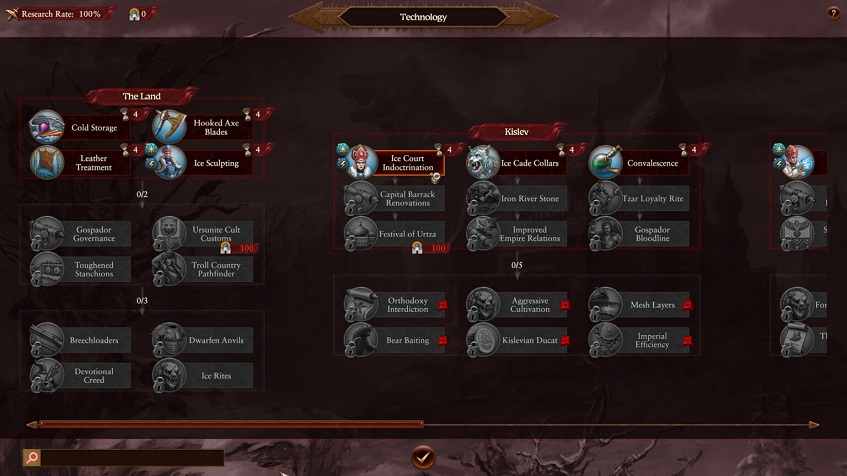
For Kislev, their technology focuses on four key areas – the land, and the three great cities. Each contains three groups of technologies, each of which requires a number from the group before to unlock. Within a group, several of the technologies may also be linked.
To begin with, a few technologies in each set are available. Progressing along the Land path simply needs a few from each box completed to unlock the next. However, the three tracks based around the great cities – Kislev, Praag, and Erengrad – require those cities to be in your faction. Each city focuses on differing upgrades across a host of units, income types, and other benefits.
As you can imagine, uniting all three cities under you gives a significant advantage in terms of what you can do and the power of your settlements and armies. It may provide some… surprising results as well.
Kislev Magic in Total War Warhammer 3
So far we know about two magic types that Kislev can use in Total War: Warhammer 3, the Lore of Ice and Lore of Tempest.
Lore of Ice
Lore of Ice, which specialises in disrupting enemy movement, freezing them to death, as well as encasing allies in protective barriers or equipping them with armour-piercing weapons.
- Frost Shield
- Ice Sheet
- Ice Maiden’s Kiss
- Frost Blades
- Death Frost
- Crystal Sanctuary
- Heart of Winter
Frost Shield – Passive
Water vapour is frozen into a shield to protect the entire force from magical attack for the duration of the spell ranged against it.
- Augment (area)
- Armour: +15
- Missle Block Chance: +12
- Unlimited effect range
- 11 seconds duration
Ice Sheet – Spell
A thin but slippery layer of ice forms on the battlefield. Those able to stay upright can only traverse it slowly or risk falling through.
- Hex (area)
- Speed: -48%
- Charge Speed: -48%
- 55m Effect range, requires target
- 17 seconds duration
- 18 seconds cooldown
Ice Maiden’s Kiss – Spell
The spellcaster breathes forth purest cold – those who succumb to it are slowed to a frozen, statuesque standstill.
- Breath
- 12 Damage Per Second (2 seconds)
- 24m/s Movement Speed
- 12m Damage Radius
- Short, wide, expanding, tear-shaped attack
- Requires enemy target
- 21s cooldown
Frost Blades – Spell
Crackling magical energy envelopes the weapons of the unit, imbuing mundane weapons with deadly new properties. Those impaled on these murderous blades will die in frozen agony.
- Augment
- Base Weapon Damage: +25%
- Armour-Piercing Weapon Damage: +25%
- Melee Attack: +24
- Requires friendly target
- 26 seconds duration
- 30 seconds cooldown
Death Frost – Spell
Reaching out, the spellcaster passes on a touch of murderous cold that slwoly but steadily kills the victim as it flows through their veins.
- Direct Damage
- 1.8K Damage over 27 seconds
- Causes damage to combatants
- Requires enemy target
- 27 seconds duration
- 26 seconds cooldown
Crystal Sanctuary – Spell
A temporary crystal dome is generated around the spellcaster and their allies, warding them against magical attack but rooting them to the spot in the process.
- Augment
- Damage Resistance: 66%
- Cannot move
- Requires friendly target
- 35 seconds duration
- 35 seconds cooldown
Heart of Winter – Spell
Those caught by this spell are gradually slowed to a frozen stop as they reacxh the very epicentre of winter’s glacial cold.
- Direct Damage (Area)
- Phase 1
- Speed: -15%
- 24 Damage over 8 seconds
- Phase 2
- Speed: -30%
- 40 Damage over 8 seconds
- Phase 3
- Speed: -45%
- 64 Damage over 8 seconds
- Phase 4
- Speed: -60%
- 88 Damage over 8 seconds
- This effect increases over time
- Causes damage to combatants
- 30 meter effect range, requires target
- 37 seconds cooldown
Lore of Tempest
Lore of Tempest, which speeds allies and sends enemies to a swift death, harried from all sides by incredible blizzards and the biting cold.
- Gust of True Flight
- Hailstorm
- Swiftwing
- Biting Wind
- Hawks of Miska
- Blizzard
Gust of True Flight – Spell
Projectiles of all kinds can be fired faster and further, as if guided by a sentient essence deep within.
- Projectiles of all kinds can be fired faster and further, as if guided by a sentient essence deep within.
- Target unit gets bonus range and accuracy.
- Overcast version changes this to all units in an area.
Hailstorm – Spell
A deluge of lacerating, fist-sized shards of ice falls from the sky, battering the foe into submission.
- A deluge of lacerating, fist-sized shards of ice falls from the sky, battering the foe into submission.
- A medium area is bombarded with explosive projectiles.
- Overcast version lasts longer and has more projectiles.
Swiftwing – Spell
The spellcaster and their allies become a blur of cyan energy which darts through the air at incredible speed before coalescing back into their natural form.
- The spellcaster and their allies become a blur of cyan energy which darts through the air at incredible speed before coalescing back into their natural form.
- All units in an area gain speed and a significant charge bonus increase.
- Overcast version has an increased affect area.
Biting Wind – Spell
The Winds of Magic are gathered into a mighty, freezing gale that slashes at the enemy with icy shards.
- The Winds of Magic are gathered into a mighty, freezing gale that slashes at the enemy with icy shards.
- Long column damage spell.
- Overcast version deals more damage and more armour-piercing damage.
Hawks of Miska – Spell
The spellcaster summons frozen spirits of fear, hatred, and dread, that loose fearful cries, tormenting all others who bear witness.
- The spellcaster summons frozen spirits of fear, hatred, and dread, that loose fearful cries, tormenting all others who bear witness.
- Randomly moving vortex that deals damage and applies Discouraged! to enemies.
- Overcast version deals increased damage.
Blizzard – Spell
Snow and ice rise from the land, freezing and blinding any and all in their path with an unnatural cold.
- Snow and ice rise from the land, freezing and blinding any and all in their path with an unnatural cold.
- Large damaging vortex that also applies Frostbite!
- Overcast version deals extra damage.
Kislev FAQ
This Q&A session was held on the official Total War Discord.
What is the most unique aspect of Kislev in Warhammer 3?
How hybrid the roster is and how most of your melee infantry units are very dependable in terms of holding a line and fighting until the bitter end.
Will Kislev play defensively with its roster, considering they are the first line of defense of the realms of man?
Kislev’s playstyle is mostly defensive, at least when fighting against factions that lack their firepower. Kislev excels when it gets to hold its ground and shoot at an enemy trying to close the distance while being peppered by frostbite arrows and Ice Sheets slowing the advance down. Winged Lancers can shatter weakened enemy units with their charges. Once the lines have met, the hybrid units can hold long enough for the hammer of the cavalry and the war bears to hit the enemy. Against the likes of Empire, High Elves or Dwarfs, Kislev will have to pivot towards a more melee-focused approach centering around the cavalry and the War Sleds.
How does playing as Kislev feel different from similar-looking factions we’re already familiar with, like the Empire and the High Elves?
Kislev’s focus on hybrid ranged units really sets them apart from Empire and High Elves. Kislev missile units are also capable of forming the battle line. Additionally, the lores of Ice and Tempest are uniquely crafted to work with the Kislev playstyle and the lack of other lores of magic really shapes what Kislev can do in battle.
In two trailers we’ve seen Bear cavalry on brown bears. What’s the difference between those and the polar bear cavalry?
So, at one point during development the Kislev War Bear Riders were riding brown bears. They are now riding white bears instead, but some of the cinematics were done before that change occurred.
Is the Snow Leopard unit a single entity or a group of them? Is it a unit or a summon?
Single-entity and both!
The Snow Leopard looked closer to hound units, but you mentioned they are single entities. Will they function more like Stegadons but with more speed and less armor/health?
Stegadon’s are as far away from the Snow Leopard as a single entity can be. The Snow Leopards are fast moving, if squishy, single entities that can use their speed to hunt down vulnerable units like mages and horse archers.
Is the Elemental Bear a unit and a summon too?
Yes! It’s both.
Will Kislev be completely land-bound rosterwise, without any flying units?
Yep, no flying polar bears here, I’m afraid!
How strong is Kislevite cavalry compared to cavalry units in the previous two games, like the Reiksguard and the Dragon Princes?
Winged Lancers are on par with Empire Knights (lighter and more offensive), Gryphon Legion are on par with Reiksguard (lighter and more offensive again). War Bear Riders are probably most comparable to a unit like Minotaurs (Great Weapons) rather than monstrous cavalry due to their entity size and number.
How do the Streltsi compare, range-wise, to Thunderers and Handgunners?
On par with them, roughly.
What kind of abilities can we expect from Kostaltyn?
He comes with the four Kislev Patriarch hymns, one each for Ursun, Salyak, Dazh and Tor. These are area-of-effect support abilities, offering a varied toolkit of healing, vigour restoration, leadership buffing, and melee attack buffs. Additionally, Kostaltyn has a host of passive abilities that inspire units around him when he is wounded and other passives that make him exceedingly hard to kill.
From the way Kostaltyn was described, it seems you want him to be in the thick of the melee, and the more damage he deals, the more his units get buffed. Is that so?
So optimal Kostaltyn play will revolve around getting him into the thick of melee with Tzar Guard or War Bear Riders on his sides, buffing them with his abilities. If the enemy tries to take Kostaltyn out, it fuels his passives further and Kostaltyn is also excellent at cheating death (he has a passive health regen that kicks in when he is close to death).
Does Katarin have any more offensive spells? I found Lore of Ice too passive – buffs and debuffs. Does she have access to another magic lore?
Katarin has three offensive spells. Ice Maiden’s Kiss is comparable to Wind Blast, but with an additional freezing effect. Death Frost is a like a slow acting, short range double Spirit Leech. Finally, you have Heart of Winter, a strong area of effect direct damage spell that slows enemies within its area of effect and gets stronger over time. Additionally, she has her bound Frost Fang ability, which is a strong explosion spell. Overall Katarin and the Lore of Ice should be an excellent damage dealer.
Will there be any other magic lores for Kislev besides Ice at the start of WARHAMMER III?
There is also the Lore of Tempest.


